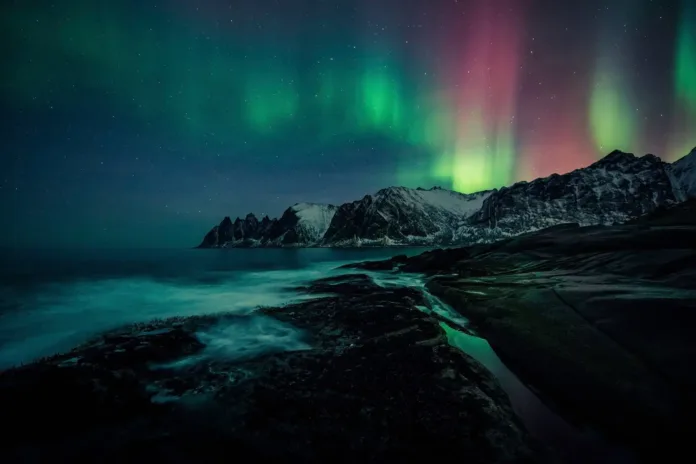Table of Contents
A detailed guide to photographing the northern lights. The sun is at the peak of its 11-year magnetic cycle, increasing the chances of seeing the aurora borealis across many regions, including parts of the US and Europe. Tonight offers another excellent opportunity to capture these vibrant magenta and green lights dancing across the sky.
How to Plan Your Northern Lights Photography Tonight
If you live within possible viewing areas like Scotland or northern England in the UK or over two dozen states in the US you can prepare with the following steps. This guide covers everything from tracking aurora visibility to choosing the right location and camera settings so you can create amazing photos of this natural phenomenon.
Step 1: Check Conditions for Aurora Visibility
We advice beginning by checking reliable sources that track space weather and aurora activity. NOAA’s Space Weather Prediction Center and AuroraWatch UK provide forecasts showing where northern lights would appear. For tonight, forecasts predict visibility in specific northern UK regions and across multiple US states.
Also, monitor the local weather forecast carefully, as clear skies are essential to see and photograph the aurora. Dark skies without clouds allow the northern lights to stand out vividly. Many social media accounts and apps offer real-time updates and push notifications to help you know when and where the best viewing spots are.
Step 2: Find the Ideal Location and Plan Your Shot
To get the clearest images, the most important thing is moving away from city lights. Light pollution can wash out the aurora and reduce photo quality. Travel to designated dark-sky parks or rural areas where the night sky is free from artificial light.
Once at a dark location, face north because the northern lights appear in the northern horizon. Using apps like PhotoPills can help plan your shot by showing the aurora’s position relative to landmarks.
For a more compelling photo, include a point of interest in the foreground such as an isolated tree, a distinctive building, or a calm body of water. Water reflects the aurora’s colors beautifully and adds depth to the composition. We recommend scouting your location before nightfall to select these elements, which enhance the overall image.
Read more on our article of, Best Budget-Friendly Camera Phones for Great Photos in 2025, published on October 3 2025, SquaredTech.
Step 3: Prepare Your Camera Gear
You do not need professional equipment to photograph the northern lights, but the right gear simplifies the process. Our research team points out that nearly any camera, including smartphone models like the Google Pixel 6, can capture the lights if used correctly. However, a mirrorless or DSLR camera with manual controls is preferred for best results.
A tripod is essential. It stabilizes the camera and prevents motion blur during the long exposures required by low light conditions. This steadiness ensures sharp, clean images.
We also recommend bringing extra batteries, as long exposure photography can drain battery life quickly in the cold temperatures that often accompany aurora sightings.
Step 4: Use Optimal Camera Settings for Northern Lights Shots
Camera settings are the key to capturing the aurora’s intricate details. We advice against overly long shutter speeds, which can blur the distinct formations into an undifferentiated color mass. Instead, a shutter speed between 1 to 5 seconds strikes a good balance, preserving sharpness while collecting enough light.
Adjusting ISO is also important. Higher ISO settings brighten the image but can introduce noise. We suggest prioritizing clarity of aurora patterns over a noise-free image, so raising ISO moderately can help reveal more detail.
Modern smartphones often have night modes that enhance low light captures automatically. Some models, like Google Pixel phones, include dedicated astrophotography modes optimized for stars and auroras. These smartphone features make northern lights photography more accessible to casual photographers.
Squaredtech encourages testing several settings when possible, as conditions vary with aurora intensity, ambient light, and weather.
Our comprehensive guide aims to equip anyone interested in photographing the northern lights tonight with practical, actionable advice. By checking aurora forecasts, choosing dark locations, preparing the right gear, and adjusting camera settings carefully, you can capture the spectacular colors and movements of this natural light display.
Remember, patience and preparation are key to successful aurora photography. Clear skies and good luck on your northern lights shoot tonight!
Stay Updates: Editors Pick


